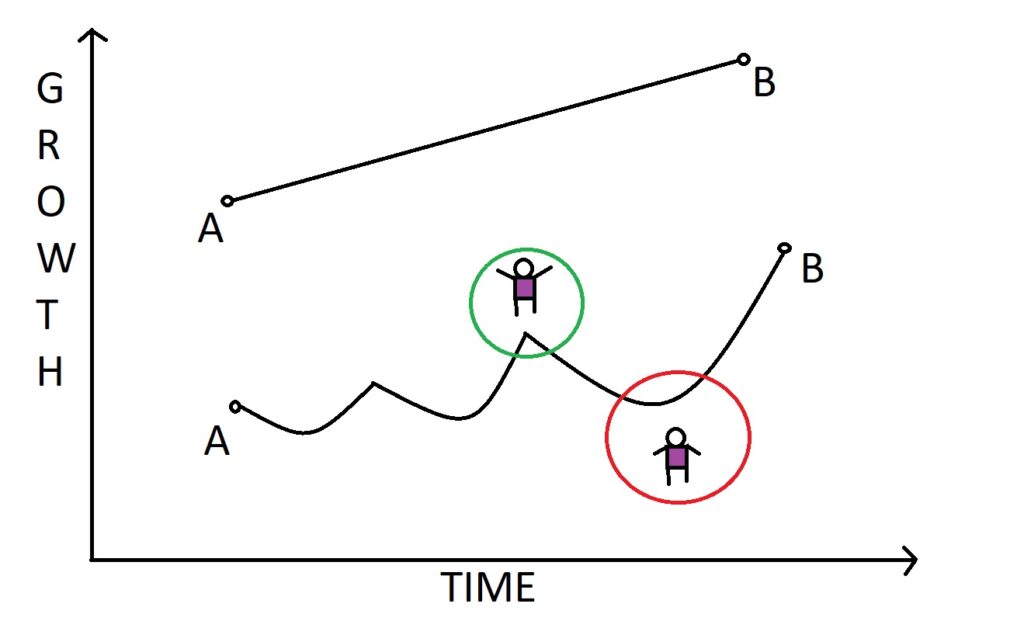Emotional healing is anything but a linear process. Think of a linear process as a step-by-step process like climbing stairs. Every single step you take moves you closer to your goal of healing in a linear fashion.
It’d be great if healing worked that way, but it doesn’t. Instead, healing is more of a ‘two steps forward, one step back’ process.
Imagine there’s a boxer near the top of the stairway. Every time you make some progress- climb some stairs- the boxer comes down and punches you in the face. That boxer is life.
You started from Step 0 and moved to Step 4 when the boxer hit you. You go tumbling down the stairs. But here’s the key: You don’t go back to Step 0. You go back to Step 1 or Step 2. Even though you got knocked down by life, you made some net progress.
If you keep moving forward, you’ll keep getting knocked down this way, and eventually, you’ll reach the top. The boxer’s punches will become powerless. Not entirely powerless, of course. You’ll rock back and forth, but you’ll be able to hold your ground at the top.
What healing looks like
When you make some progress in personal growth, you feel happy. You think everything in your life is finally going to be better. Then comes the punch, and you get knocked down.
When you get knocked down, you think all the progress you made was for nothing. Worse, you may even come to believe that it’s impossible to change.
You ignore the fact that you’ve moved from Step 0 to Step 1. You miss the fact that you’ve made some net progress.
If you’re not sold on this boxer analogy, take a look at this graphic that shows what healing looks like:

You might be wondering what those red and green circles are. I call them bubbles of awareness.
You see, we humans have this metaphorical bubble of awareness around us that restricts the information we can attend to. In other words, we tend to be more aware of the things that are proximal to us in space and time.
It’s a variation of what psychologists call the availability bias.
It has been an essential feature of our psychology that helped our ancestors attend to the here and now. Because, unlike modern times, survival in ancestral times depended more on how well you attended to the here and now.
When we make progress and reach a peak, that green bubble makes us think that all is well and good in our lives.
When we get knocked down, that green bubble turns red and makes us believe that all is wrong with our lives.
The danger with the green bubble is blind optimism and ignoring potential risks. The red bubble is nastier, though. It can lead to frustration and plunge you into the depths of depression.
As the figure shows, the healing process is not a straight line from A to B. It’s an upward trending curve with many peaks and valleys, with lots of green and red circles.
Focusing on the bigger picture
If you learn to see the bigger picture, you can better handle your low, red circle days. Of course, your mind wants to default to seeing what’s immediate because that’s how it’s wired. But you have to force yourself to see more than what’s near.
This requires significant inner work and practice, but you’ll get there. Once you do, you’ll no longer be swayed much by the reds and the greens and focus on the bigger picture.
You’ll see that even though life knocked you down, you’ve made some net progress.
One misstep doesn’t mean the journey isn’t worthwhile.
One bad day doesn’t mean the whole self-improvement plan has been ruined.
Failing to stick to your routine one day doesn’t mean routines can’t work for you.
If you look at the bigger picture, you’ll realize how far you’ve come from your starting point.
Say you failed to stick to your exercise regimen for one week. Recall the times when you didn’t exercise at all. You’re in a much better position now. You’re only skipping days and weeks instead of months and years.
Time alone doesn’t heal
If you have a bad relationship with a loved one and you seem to fall back into the same patterns with them, you’re unlikely to heal without some inner reflection. Time alone doesn’t heal wounds. You’ll have to work on yourself.
Every time you repeat a pattern, reflect on what happened and why. You could also seek professional help.
This ‘going back to the drawing board’ enables you to see things differently and try new approaches and behaviors. Without this important inner work, you’ll keep repeating your patterns unconsciously.
If you do the proper inner work, you’ll find that you decrease the frequency of your patterns. You make real progress.
And just when you’re basking in your progress, an old trigger may re-open the wound, and you slip back into the same pattern. You think all the progress you’d made was for nothing.
This will keep happening till you get to a point where looking back, you can’t help but see how far you’ve come.
Healing hurts, and it’s okay
Another habit that’ll significantly help you heal faster is taking your feelings seriously, especially negative feelings. People tend to stuff away negative feelings because they’re hard to deal with.
But those negative feelings don’t go away. They pile up on each other and create a storm.
Prevention is better than cure.
The best way to deal with negative emotions is to deal with them head-on when they arise. Acknowledge and process them, so they don’t pile up.
Experiencing some hurt now by facing your negative emotions is way better than experiencing more pain later when they pile up.

